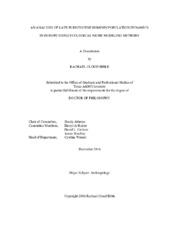| dc.description.abstract | This dissertation addresses questions concerning the patterns of population dynamics between Late Neandertals and early modern humans (EMHs) during the Late Pleistocene of Europe and the fluctuation of those patterns over time. Proposed models of Neandertal extinction and EMH expansion hypothesize certain patterns of behavioral responses to fluctuating climate and possible biogeographic features, such as the hypothesized Ebro River Frontier (EFM). Analyses designed to illuminate these potential patterns and test the presence of proposed biogeographic frontiers were conducted using the Genetic Algorithm for Rule-Set Prediction (GARP), originally designed for ecological research to model the geographic extent of suitable habitat associated with samples of presence-points and make well-informed hypotheses about the fundamental niche parameters of a species.
Three different paleoenvironmental reconstructions that shortly precede Neandertal extinction were used in this study to model the possible change in these patterns over time centered on Heinrich Event 4 (H4): 1) the Pre-H4 (43.3-40.2 ky cal BP), 2) the H4 (40.2-38.6 ky cal BP), and 3) the Post-H4 (38.6-36.5 ky cal BP). For the time period of each reconstruction, multiple experiments were run with different samples of locations absolutely dated to each time period designed to capture Neandertal and EMH presence. These samples move from more theoretically conservative groups of morphologically diagnostic fossil hominin remains to those which included Middle Paleolithic (MP) and Upper Paleolithic (UP) sites. The resulting consensus prediction models were statistically validated with a combination of Pearson’s p-value, cumulative binomial probabilities, and Partial-ROC analyses.
The results of this dissertation indicated that Neandertals and EMHs display different behavioral responses to the H4. Neandertal suitable habitat contracts during the H4 and is thereafter confined to southern Europe. The total area predicted for Neandertals does not reach its Pre-H4 levels again. EMH suitable habitat does not show the same southern confinement. The total area predicted for EMHs remains steady throughout the H4, a short glacial period, and increases during the Post-H4. The geographic overlap for Neandertal and EMH suitable habitat is the most extensive during the Pre-H4. Despite similar niches, Neandertals and EMHs display different behavioral responses to climatic fluctuations. | en |


